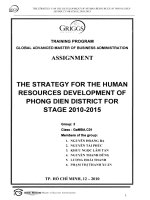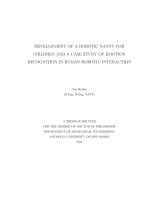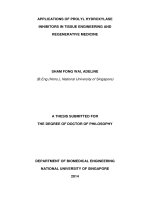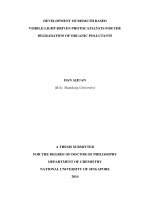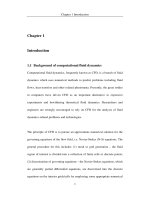Development of chitin based materials for tissue engineering applications
Bạn đang xem bản rút gọn của tài liệu. Xem và tải ngay bản đầy đủ của tài liệu tại đây (2.16 MB, 173 trang )
DEVELOPMENT OF CHITIN BASED MATERIALS FOR
TISSUE ENGINEERING APPLICATIONS
CHOW KOK SUM
NATIONAL UNIVERSITY OF SINGAPORE
2002
DEVELOPMENT OF CHITIN BASED MATERIALS FOR
TISSUE ENGINEERING APPLICATIONS
CHOW KOK SUM
(B.Sc. Hons, NUS)
A THESIS SUBMITTED
FOR THE DEGREE OF DOCTOR OF PHILOSOPHY
DEPARTMENT OF CHEMISTRY
NATIONAL UNIVERSITY OF SINGAPORE
2002
Acknowledgement
I would like to express my most heartfelt thanks to Professor Eugene Khor for his
guidance and supervision throughout the course of this project. Without his constant
support and patience, this project will not have been accomplished.
My special appreciation to my friends and fellow lab mates for their invaluable
friendship and encouragement. Grateful to Irene, Mdm. Loy, Mr. Sim, Joanne and Ms.
Tan for their technical support. Many thanks to Nelda, Sarah, Li Shan, Dawn, Ze
Gang, Selina, Ling Ling, Xia Bing, Chin Teng, Ze Han and many others for their
companionship and laughter during good and bad times.
Last but not least, I would like to show my gratitude to National University of
Singapore for granting me the research scholarship. I am also grateful to the Dept of
Chemistry for invaluable education and training during my undergraduate and
postgraduate years.
TABLE OF CONTENTS
CHAPTER ONE: INTRODUCTION
PREFACE 1
1.1) CHITIN
1.1.a) Introduction 4
1.1.b) Sources 6
1.1.c) Structural Classification 8
1.1.d) Solubility 9
1.1.e) Biodegradability 10
1.1.f) Health Issues, Benefits and Risks 11
1.1.g) Limitations 13
1.2) TISSUE ENGINEERING
1.2.a) Introduction 14
1.2.b) Cell-Polymer Matrix Construct 18
1.2.c) Polymer Matrix 19
1.2.d) Cell-Polymer Matrix Generation 20
1.3) AIM OF PROJECT 22
1.4) REFERENCES 24
CHAPTER TWO: FABRICATION OF CHITIN MATRIXES
2.1) INTRODUCTION 34
2.1.a) Variation of Pre-Lyophilization Process and Drying Methods 36
2.1.b) Internal Bubbling Process (IBP) 37
2.2) EXPERIMENTAL
2.2.a) General 38
2.2.b) Variation of Pre-Lyophilization Process and Drying Methods 44
2.2.c) Internal Bubbling Process (IBP) 48
2.3) RESULTS AND DISCUSSION
2.3.a) Variation of Pre-Lyophilization Process and Drying Methods 52
2.3.b) Internal Bubbling Process (IBP) 66
2.4) SUMMARY 81
2.5) REFERENCES 83
ii
TABLE OF CONTENTS
CHAPTER THREE: CHEMICAL MODIFICATION OF CHITIN
3.1) INTRODUCTION 90
3.1.a) Synthesis of New Fluorinated Chitin Derivatives 93
3.1.b) Synthesis of Chitosan-Polypyrrole Hybrids 94
3.1.c) Synthesis of Reversible Water Swellable Chitin Gel 96
3.2) EXPERIMENTAL
3.2.a) General 98
3.2.b) Synthesis of New Fluorinated Chitin Derivatives 99
3.2.c) Synthesis of Chitosan-Polypyrrole Hybrids 102
3.2.d) Synthesis of Reversible Water Swellable Chitin Gel 108
3.3) RESULTS AND DISCUSSION
3.3.a) Synthesis of New Fluorinated Chitin Derivatives 110
3.3.b) Synthesis of Chitosan-Polypyrrole Hybrids 123
3.3.c) Synthesis of Reversible Water Swellable Chitin Gel 135
3.4) SUMMARY 141
3.5) REFERENCES 143
CONCLUSION 154
APPENDIX 158
PUBLICATIONS 163
iii
SUMMARY
As the field of tissue engineering emerged in the last decade, it has surfaced as a
promising alternative approach in the treatment of malfunctioning or lost organs. An
important focus in this new approach is the search for suitable materials for development
of a variety of tissue engineering applications. Chitin has been known to science for
almost two centuries but the development of chitin chemistry and its application has
lagged behind cellulose.
Chitin is abundant in nature due to its compact intractable and inert structure
resulted from strong hydrogen bonding network. Chitin is known as one of the second
most abundant polysaccharides in nature, after cellulose. In crustaceans, chitin is present
in a complex structure with calcium carbonate, forming the rigid skeleton of carapace,
shell and tail. In insects, chitin is the main building block of the back plate. This
intractable characteristic of chitin is superior in the animal / plant kingdom as protective
skeleton but is a major disadvantage for chemical / physical modification. Therefore
more efficient methods of reacting or modifying chitin (especially α-chitin as it is the
most abundant of the 3 types of naturally occurring chitin) is necessary, in order to utilize
this biomass as a major renewable raw materials.
This dissertation presents new methodologies of developing chitin-based materials
for tissue engineering applications. In tissue engineering, a temporary matrix is required
to serve as an adhesive substrate for the implanted cells and a physical support to guide
the formation of the new organs. Investigations were conducted to develop a novel
processing technique to fabricate highly porous chitin with a wider range of pore sizes
iv
SUMMARY
that can accommodate the ever-increasing number of potential tissue engineering
applications. In this study, we also explore important parameters that affect the
morphology, pore size, water uptake ability and in vitro cytotoxicity of these porous
matrixes.
To date, only examples of deoxyfluorocellulose have been reported
1, &2 3
.
Fluorinated chitin derivatives were not known although the bromination, chlorination and
iodination of chitin have been investigated
4,5
. In this dissertation, we present the first
preparation, characterization and in vitro cytotoxic assessment of deoxy-fluorinated
chitin.
Among the conducting polymers, polypyrrole has been one of the most widely
studied because of its good chemical and thermal stability, ease of preparation and
electroactivity
6, &7
8
. We have opted to introduce carboxylic acids substituents onto the
C-3 position of the pyrrole monomer. These in turn are made to react with the amino
groups in chitosan creating covalent bonds between the polymers. The result is a
polypyrrole-chitosan hybrid material that is potentially biocompatible and electrical
conducting.
The incorporation of substantial amounts of carboxylic group into the intractable
chitin backbone produced a highly swelled chitin hydrogel. Swelling characteristics of
the chitin hydrogel was determined by the hydrophilicity of the polymer. By modifying
the degree of hydrophilicity of the hydrogel, we could control its swellability and
v
SUMMARY
intractability. Depending on the application, the degree of swelling could be customized
accordingly.
1
N. Kasuya., K. Iiyama, G. Meshitsuka, A. Ishizu, Preparation of 6-O-deoxy-6-
fluorocellulose, Carbohydrate Research, 260, 251, 1994.
2
N. Kasuya, K. Iiyama, A. Ishizu, Synthesis and characterization of highly substituted
deoxyfluorocellulose acetate, Carbohydrate Research, 229, 131-139, 1992.
3
N. Kasuya, K. Iiyama, G. Meshitsuka, T. Okana, A structural study of fluorinated
cellulose: crystallization of fluorinated cellulose by conversion treatments used for
cellulose, Carbohydrate Polymers, 34, 229-234, 1997.
4
M. Sakamoto, H. Tseng, K. I. Furuhata, Regioselective chlorination of chitin with N-
chlorosuccinimide triphenylphosphine under homogenous conditions in lithium
chloride N,N-dimethylacetamide, Carbohydrate Research, 265, 271-280, 1994.
5
H. Tseng, K. Takechi, K. I. Furuhata, Chlorination of chitin with sulfuryl chloride under
homogeneous conditions, Carbohydrate Polymers, 33. 13-18, 1997.
6
M.T. Nguyen, A. F. Diaz, A novel method for the preparation of magnnetic
nanoparticles in a polypyrrole powder, Adv. Materials, 858, 1994.
vi
SUMMARY
7
S. Machida, S. Miyata, A. Techagumpuch, Chemical synthesis of highly electrically
conductive polypyrrole, Synthetic. Met, 31(3), 311, 1989.
8
S. Machida, S. Miyata, A. Techagumpuch, Chemical synthesis of highly electrically
conductive polypyrrole, Synthetic. Met., 1989, 31, 311.
vii
CHAPTER ONE: INTRODUCTION
CHAPTER ONE: INTRODUCTION
PREFACE
Polysaccharides are naturally occurring macromolecules, built by condensation of
high molecular weight polymers with simple monosaccharide units. In contrast to
functional roles of nucleic acids and proteins, they have been considered to be substances
of less importance and regarded primarily as structural materials and suppliers of water
and energy. However, in recent years, polysaccharides inherent properties in biological
systems are better understood and interest in polysaccharides chemistry is unabated. The
development of new delicate methods of extraction, separation, modification and analysis
has resulted in the discoveries of novel polysaccharides and realization of their potential
applications
1
.
Among the polysaccharides, cellulose and chitin are the two most abundant
biopolymers. Although cellulose has been studied extensively, only limited attention has
been paid to chitin. In 1811, Professor Braconnot, director of botanical garden at the
Academy of Sciences, Nancy, France, discovered a substance in fungi and named it
“fungine”. This discovery occurred 30 years before Payen’s isolation of cellulose
2
. In
1823, Odier isolated an insoluble residue from the elytrum of the cockchafer beetle with
hot potassium hydroxide solution and called it chitin. The name chitin is derived from the
Greek word “chiton”, meaning “coat of mail” since it functions as protective coat for
invertebrates. Despite the early discovery and an annual production of at least 10
gigatons/year in the biosphere, chitin remains an almost unused biomass resource
3
.
Page 2
CHAPTER ONE: INTRODUCTION
The main driving force for the development of new applications for chitin and its
derivatives lies with the fact that these polysaccharides represent a renewable source of
natural biodegradable polymers. Since chitin is the second most abundant biomass after
cellulose, academic and industrial scientists are faced with a great challenge to find new
and practical applications for this material. Among the potential explorations identified
for chitin based materials is in the emerging field of tissue engineering.
Tissue engineering provides an interesting glimpse into the future of medicine.
Using this technology, it will be possible for doctors to routinely repair or replace failing
or aging body parts tissues with laboratory-grown parts such as bone, cartilage, blood
vessels, and skin
4
. There has also been an increasing public and media interest in tissue
engineering, from the first tissue engineered skins to be approved by the US Food and
Drug Administration (FDA) to the controversial use of human embryonic stem cells,
which are taken from aborted fetuses or discarded embryos
5, & 6 7
. Although there is
growing excitement in the field of tissue engineering, it is still in its infancy. Success will
depend largely on the ability to understand complex cellular interactions and application
of appropriate scaffolding materials, growth factors and cell populations.
This dissertation is divided into two parts, namely the fabrication of chitin matrixes
and chemical modifications of chitin. The first part of the thesis will present the research
focused on developing new methods to fabricate chitin matrixes. These matrixes have the
potential to provide a structural framework for cells and facilitate formation of new
tissues in tissue engineering. The second part of the thesis will investigate the chemical
Page 3
CHAPTER ONE: INTRODUCTION
modifications of chitin that can impart various desirable characteristics in tissue
engineering.
1.1) CHITIN
1.1.a) INTRODUCTION
Chitin
8
is a linear amino polysaccharide consisting of -1, 4-linked N-acetyl-D-
glucosamine. Chitin is analogous in chemical structure to cellulose (Figure 1), where
substitution of the C2 hydroxyl group (OH) for the acetamide group (NHCOCH
3
) as the
only structural difference. Chitosan is known as the deacetylated form of chitin. The main
difference between chitin and chitosan lies in the degree of deacetylation. A fully
acetylated or deacetylated polymer is not naturally occurring. The only means to
differentiate chitin from chitosan is by considering their respective acetyl contents or
degree of acetylation. It is generally accepted that chitosan is the one with degree of
acetylation below 50%. Hence, chitin was termed to those having degree of acetylation
over 50%
9
. Chitin and chitosan are among the polysaccharides found in nature to have
nitrogen attached to the biopolymer backbone. Other nitrogen-containing polysaccharides
include polygalactosamine and mucopolysaccahrides.
Page 4
CHAPTER ONE: INTRODUCTION
O
OH
O
NHAc
OH
O
OH
NHAc
OH
O
n
n
O
OH
O
OH
OH
O
OH
OH
OH
O
n
O
OH
O
NH
2
OH
O
OH
NH
2
OH
O
Cellulose
Chitin
Chitosan
Figure 1: Chemical structures of cellulose, chitin and chitosan.
* where Ac = COCH3 group.
Page 5
CHAPTER ONE: INTRODUCTION
1.1.b) SOURCES
Chitin is one of the most plentiful polysaccharides produced in nature by
biosynthesis. It only ranks second to cellulose as the most abundant organic compound on
earth
10
. Cellulose is the key carbohydrate that plants use to build cell walls. Likewise to
these compounds, chitin also contributes strength and protection to the organism. Chitin
is widely found in animals particularly in the shells of crustaceans, such as shrimp, crab
as well as in the exoskeleton of marine zoo-plankton. It is present in a complex structure
with calcium carbonate, forming the rigid skeleton of carapace, shell or tail of the
organism.
Chitin is also found in the insect kingdom, it forms the main building block of the
back plate. The chitinous shell or exoskeleton, does not grow, and is periodically molted.
After the old shell is shed, a new, larger shell is secreted by the epidermis, providing
room for future growth of the insect.
Apart from animals, chitin is also found in plants. It is present in vast majority as
the principle protective layer in the cell walls of yeast, mushrooms and most classes of
fungi (Figure 2). Chitin’s occurrence as main structural component of the cell wall
provided strong and intractable material for protection.
Page 6
CHAPTER ONE: INTRODUCTION
In fungi, chitin is present in cell walls in the form of micro-fibrils
1,11
. Chitin is
also the major organic component in crustaceans
12
. Every year, almost 100 billion tons of
discarded crustacean shells sink through the world’s oceans. This has attracted much
attention to crustaceans as a source of raw material for chitin production
13
. Therefore,
most of the chitin produced commercially is derived from crab, shrimp, and crayfish
exoskeletons obtained as waste from the seafood processing industry
14
.
Figure 2: Adapted schematic diagram showing location of chitin fibers in an arthropod
cuticle
15
.
Page 7
CHAPTER ONE: INTRODUCTION
1.1.c) STRUCTURAL CLASSIFICATION
Chitin and chitosan tend to adopt a helix structure. The helical strands can be
classified into three crystalline forms namely , and (Figure 3). These crystalline
networks are aligned by chains in bonded “layers” connected by N-H
…
O=C hydrogen
bonds through the C2 amide linkages
16, 17
. The most abundant form is -chitin, usually
found in crabs. In -chitin, the molecules are aligned in an anti-parallel manner. This
molecular arrangement is favorable for the formation of strong hydrogen bonds resulting
in the most stable and abundant of the three crystalline forms. In order to utilize the
abundance of -chitin, it is used as the raw material in this project.
Figure 3: Representation of molecular arrangement for and -chitins indicating
hydrogen bonding interactions
3
.
Page 8
CHAPTER ONE: INTRODUCTION
-chitin is usually found in squids and cuttlefish
11
. Molecules in -chitin are
packed in a parallel fashion, producing weaker intermolecular interactions. -chitin is
easily transformed into -chitin. -chitin is a mixture of and -chitin with both parallel
and anti-parallel arrangements.
1.1.d) SOLUBILITY
The strong inter / intra molecular hydrogen bonding network of -chitin is the key
basis for its intractability and insolubility in the common solvents used for dissolution of
cellulose. It swells slightly in basic solvents and does not swell at all in common organic
solvents. It is found to be soluble only in special solvents such as 5% lithium chloride
(LiCl) in N, N-dimethylacetamide (DMAc) or a mixture of DMAc with N-methyl-2-
pyrrolidone (NMP) containing 5-8% LiCl. Chitin was also reported to dissolve in
hydrochloric acid or sulfuric acid but observed to experience hydrolysis under heating
and prolonged stirring
3
. Therefore, under mild conditions in dilute acids, chitin is not
soluble. In fact, chitin is purified by stirring in 50% HCl at 25
o
C for 1 day. In sharp
contrast to the intractable nature of -chitin, -chitin swells highly in water because of the
weak intermolecular hydrogen bonding. Chitosan, the deacetylated form with a basic
amino group is soluble in aqueous acidic medium with pH < 6.5; such as in dilute acetic,
lactic and hydrochloric acid solutions. Thus, chitosan precipitates at pH above 6.5 and its
applications was limited owing to the insolubility at neutral or high pH region
18
.
Page 9
CHAPTER ONE: INTRODUCTION
1.1.e) BIODEGRADABILITY
The earliest report of enzymatic degradation of chitin is that of Beneke in 1905
2
.
Both chitin and chitosan are reported to be biodegradable
19
in nature. The biodegradation
process is carried out by many varieties of microorganisms
20
. In most instances, the
complete enzymatic hydrolysis of chitin to N-acetyl-D-glucosamine requires a system of
chitinolytic enzymes. The chitinolytic enzymes comprise of chitinase 1,4-β-poly-N-
acetylglucosaminidase (EC 3.2.1.14), β-D-acetylglucosaminidase (EC 3.2.1.30) and β-N-
acetylhexosaminidase (EC 3.21.52). Chitinase 1,4-β-poly-N-acetylglucosaminidase (EC
3.2.1.14) performs random hydrolysis of the chain, β-D-acetylglucosaminidase (EC
3.2.1.30) hydrolyzes the terminal non-reducing sugar moiety and β-N-
acetylhexosaminidase (EC 3.21.52) removes the successive sugar units from the non-
reducing end
21
.
Chitinolytic enzymes (CE) are also present in higher plants, even though plants do
not have chitin as a structural component. This characteristic may be attributed to the
self-defense mechanism of plants against pathogenic microbes and insects that have
chitin as their exoskeleton
22
. CE have also been found in the digestive tracts of some
vertebrate species such as rodents and more recently discovered in humans
23
. The
existence of chitinolytic enzymes in the gastrointestinal tract and lung may suggest their
possible role in digestion and/or defense.
Page 10
CHAPTER ONE: INTRODUCTION
Chitin in humans is also degraded by lysozyme
24
. The degree of deacetylation of
chitin affects its biodegradability and chitin with a degree of deacetylation of 0.7 is most
susceptible to lysozyme
25,26
. This is attributed to the strong interaction between the acetyl
group of chitin with subsite-C in the active cleft of lysozyme
27
. The susceptibility to
lysozyme degradation has formed the basis of the medical applications of chitin
28
.
Among the examples is the gradual re-sorption of chitin dressing as artificial skins with
simultaneous replacement of natural tissue
29
. Due to the lysozymic degradation process,
sustained release of an active ingredient from chitin films and micro spheres can also
occur
30
.
1.1.f) HEALTH ISSUES BENEFITS AND RISKS
For years, chitin and its derivatives have been used for nutritional and medicinal
purposes in the Far East. Many people do take dietary supplements made from chitin and
chitosan to improve their health. They also cited improvements in skin, hair and nail
health.
The low toxicity of chitin was demonstrated to be mostly due to its
biodegradability and the fast metabolization of hydrolysate from the system
31
. Studies
showed that chitin and chitosan have a low degree of toxicity with LD
50
in laboratory
mice is > 10g/kg body weight, which is close to that of salt and sugar
32
. Chitin was
reported to show good biocompatibility as a wound-healing accelerator
33
.
Page 11
CHAPTER ONE: INTRODUCTION
Muzzarelli reported that oral administration was recognized as safe, non-toxic and
deprived of any activity on certain drugs
34
.
A beneficial effect of chitin-chitosan as a food supplement is the reduction of
plasma cholesterol and triglycerides due to its ability to bind dietary lipids, thereby
reducing intestinal lipid absorption. It was also reported to improve the HDL-
cholesterol/total cholesterol ratio
35, 36
. Plasma cholesterol in animals on cholesterol-free
diet, however, is not affected; indicating that endogenous biosynthesis of cholesterol
remains intact
37
. Chitosan acts by forming gels in the intestinal tract which entrap lipids.
Unfortunately, other nutrients, including fat-soluble vitamins and minerals also have the
tendency to be trapped, thus interfering with their absorption
38
.
Dietary chitin-chitosan may influence calcium metabolism by accelerating its
urinary excretion. The reported undesirable effects are a marked decrease in plasma
vitamin E level, reduction in bone mineral content and growth retardation
27
. Ascorbic
acid or vitamin C, enhances gel formation of chitosan, thereby increasing the reduction of
plasma cholesterol. Bile acid composition and short-chained fatty acid content in the
cecum are altered by chitosan which impedes lipid emulsification and absorption
35
.
Chitin-chitosan was also reported to inhibit in vitro growth of microorganisms
including Candida and in vivo has a protective effect on Candida infection. The
antibacterial and anti-yeast activities of chitin-chitosan are desirable properties and may
be useful in preventing infection of wounds by direct application
35
.
Page 12
CHAPTER ONE: INTRODUCTION
On prolonged ingestion, however, it may alter the normal flora of the intestinal
tract that may result in the growth of resistant pathogens. Although studies with cells, on
tissues and animals indicate that chitin-chitosan promotes wound healing, increases
immune response, and possesses antitumor activity
39
, these claims need to be further
validated in human subjects by clinical trials. Therefore, certain medical precautions
should be observed with long-term ingestion of high doses of chitin-chitosan to avoid
potential adverse metabolic consequences
40
.
1.1.g) LIMITATIONS
The acetamido groups in chitin lead to strong hydrogen bonding producing
compact structures. The strong inter / intra molecular hydrogen bonding in the 3D
crystalline structures of chitin as well as its high molecular weights (usually in the order
of 10
6
) results in its insolubility in most organic solvents. This intractable characteristic
of chitin is superior in the animal / plant kingdom as protective skeleton but is a
disadvantage for chemical / physical modification. Chitin also exhibits poor accessibility
/ reactivity to reactants when compared to cellulose. In chitosan, the presence of less
acetamido groups has produced a weaker hydrogen-bonding network. The disruptions of
hydrogen bonding in chitosan enable it to be soluble in acidic medium and be
manipulated for various applications. Therefore, utilization of chitin as a raw material has
been limited to a handful of applications.
Page 13
CHAPTER ONE: INTRODUCTION
1.2) TISSUE ENGINEERING
1.2.a) INTRODUCTION
Tissue Engineering is a potential new area for development that brings
together various disciplines such as bioengineering, material science, chemistry, cellular
biology and medicine. Fundamentally, tissue engineering aims to develop biological
replacements that restore, sustain or improve tissue function. It also aims to apply the
biological replacements to medical situations where tissue has been lost through trauma
or disease
41
. Tissue engineering is defined as the application of engineering disciplines to
either maintain existing tissue structures or to enable tissue growth
42
(Figure 4).
Surgical approaches to overcome tissue loss include organ transplantation
from one individual to another, tissue transfer from a healthy individual to an affected
site in the patient and replacement of tissue function with mechanical devices (such as
prosthetic valves and kidney dialysis machines). Other medical strategies may include
pharmacology supplement of the metabolic products of missing or non-functional tissue.
Page 14
CHAPTER ONE: INTRODUCTION
Figure 4 Schematic adaptation of the tissue engineering approach
42
.
While these approaches incorporate enormous advancements in the field of
medicine, they also have some intrinsic limitations. Organ transplantation is constrained
by the number of available donors. More than 50,000 people are on the transplant waiting
lists for various organs in the United States alone. Furthermore, immuno-suppression in
organ transplant beneficiary carries a lifetime risk of potential morbidity and mortality.
Page 15
CHAPTER ONE: INTRODUCTION
Transferring tissue from the donor to another site in the same individual often entails
various shortcomings such as imperfect match for the reconstructive need or potential for
donor site morbidity and complication in the transferred tissue. Mechanical devices on
the other hand, may have limited resilience in a biological system, lack of mechanisms
for self-repair. It also may sustain inflammation or infection at the transplant site, impose
anti-coagulation and will not develop as the recipient grows. These shortcomings have
been recognized and studied. Therefore, current researchers have look beyond
transplantation for solutions
43
(Table 1).
Tissue engineering is one of a new generation of treatment strategies that provide
alternative solution to the replacement or restoration of tissue or organ function with
constructs that contain specific growing populations of living cells. The transplantation of
cells on matrixes is distinguished from the introduction of isolated cells by the presence
of a biological scaffold. It differs from the encapsulated systems in that cells have direct
contact with the host site rather than is separated by a semi-permeable membrane.
Three avenues have been explored in creating new tissues namely, a) introduction
of living cells; b) development of the encapsulated systems and c) transplantation of cells
into the matrixes
44
.
Page 16

